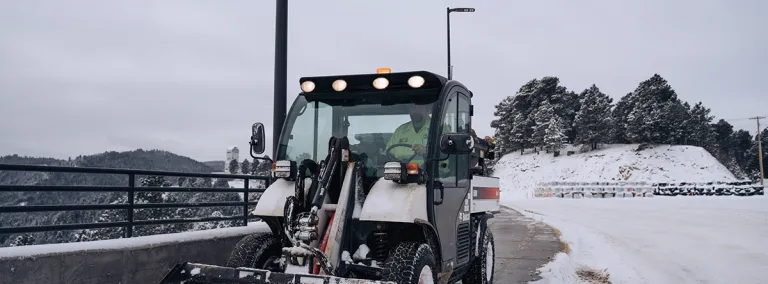SURF crews remove snow in South Dakota’s snowiest town
SURF's 226 surface acres are blanketed by thousands of tons of snowfall each year
With an average of 134 inches of snowfall each year, Lead is by far the snowiest city in South Dakota. In 2011, it was ranked as the fifth snowiest city in the nation. All this snow makes Lead, a mountain town in the midst of the Black Hills National Forest, a wintertime destination. Winter sports enthusiasts ski and snowboard at Terry Peak, snowshoe through the pine forest, snowmobile over groomed trails and even ice climb the face of frozen waterfalls.
But for some, winter weather is a logistical challenge.
Sanford Underground Research Facility (SURF) is located on a hilltop in Lead, where its 226 surface acres are blanketed by thousands of tons of snowfall each year.
“It takes a lot of attention and resources to keep our people safe throughout the winter storms,” said Dan Regan, buildings and grounds foreman at SURF.
SURF’s “Snow Plow Plan” is outlined in a thick binder. The plan details areas to be cleared of snow, equipment used to plow snow and sand roads, and photos of any potential hazards that could be obscured by snow.
With each snowfall, snow needs to be removed from large work yards at the base of the Yates and Ross headframes, all parking lots, the grounds surrounding the Waste Water Treatment Plant, and every road and sidewalk in-between. The crews also clear access to the Oro Hondo Fan and Substation in Kirk Canyon, Ellison Road, and the sidewalks and observation deck at the Sanford Lab Homestake Visitor Center.
Members of the snow removal team are identified as “essential workers” and include employees from various crews at SURF, including shaft crews, hoist maintenance and electricians. When snow begins to fall, this team gets to work.
“This team is dedicated to making it safe for people to be onsite, even if that means reporting to work at 2 a.m. or rotating shifts during a multi-day storm,” Regan said.
The snow removal team is outfitted with a fleet: two loaders, three plowing trucks, two sanding trucks, two skid steers and a Toolcat utility machine. With these machines, the crew can clear, sand and de-ice the entire property.
They weren’t always this well-outfitted. Regan remembers when the 2013 winter storm Atlas hit, dumping 55 inches of snow on Lead in just two days. “We were running our one loader and two skid steers 24/7,” Regan said. “There was just no keeping up with it!”
Plowed snow quickly accumulates into large piles, which can take months to melt completely. “In the event of a large snowstorm, we have to stockpile snow and haul it off property, but that’s only after the heavy-hitters,” Regan said.
With the occasional snowfall in June, the snow season is never “quite” over. But even after the snowfalls have subsided, there is still work to do. In the spring, the crew does full inspections of all snow removal equipment. And by August, teams are already coordinating in anticipation of the first snowfall.
With all this work, at least the crews get to play in the snow on the weekends, right?
“Not me! All winter has been to me is work,” Regan said with a chuckle.
